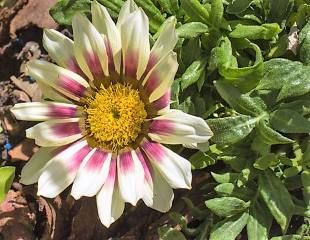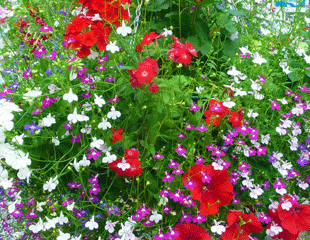
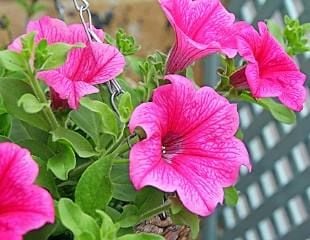
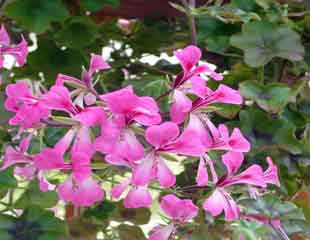
Best Summer Bedding Plants
Summer bedding plants are big gardening business, and with so many to choose from it's a dazzling array. Mostly, it is a personal choice as to what suits you and your garden. Very popular are soft pastels colours with baskets of petunia, verbena, lobelia and silver foliage plants such as Cineraria Silverdust. In contrast are strong primary oranges, yellows and reds of Begonia and Marigolds.
The colour choice is personal, but it is still worth knowing a few helpful facts about bedding plants before parting with your money.
- Which bedding plants are hardy, (almost none,)
- second which are slug magnets and likely to be destroyed,
- which bedding plants require endless dead-heading and are labour intensive,
- and finally those bedding plant flowers which only open if it's sunny which can be limiting in an English summer.
Bedding plants are not frost hardy.
The first point to know is that bedding plants are not frost hardy. Although bedding plants are on sale from around late March/early April, almost all are not hardy (sweet peas being the major exception. )
This means if planted outside, frost will kill bedding plants, and cold weather will make them sulk. Bedding plants planted outside in cold weather will struggle, and you may find that they get off to a very slow flowering start. If the weather takes a turn for the worse, keep the plants under cover either in a greenhouse, conservatory or sheltered spot. If you have time and space, planting the bedding plants into containers and hanging baskets and growing on in the greenhouse gives them a head start to get established. Often, when you are selecting bedding plants and hanging baskets at the garden centre, growers have nurtured them in a sheltered spot with near perfect conditions. No matter the conditions, it is advisable to wait until all risk of frost has passed before planting bedding plants. More information about when to plant out bedding plants.
Slug resistant bedding plants
Growing bedding plants just to have them consumed by slugs is no fun.
Some bedding plants are very attractive to slugs, others less so. You may want to select easy to grow slug resistant bedding. Those which are slug magnets are petunia (above centre image), bizzie lizzies (Impatiens,) verbena, pansies, and the most attractive of all to slugs, marigolds. If your garden is prone to slugs, and you want an easier gardening life, steer clear of these.
Bedding plants less liked by slugs are Pelargoniums common name Geranium (above image far right), Begonias, the English pot Marigold (calendula officinalis, image below left) Fuchsias, Lobelia (image above far left), and Snapdragons ( Antirrhinums)
Compare below the Calendula (pot marigold) illustrated further down below left and the traditional pom pom shaped Marigold image below right. Both are lovely, but with the traditional marigold you will need robust slug protection even if you grow them off the ground in a tall pot. The slugs consider Marigolds nectar of the gods. They will slime their way up the pot and munch away on the Marigolds, leaving you with a few slimy stalks.
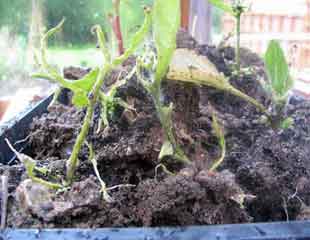
Still, if not too badly ravaged, you can rescue the plant, see below.
If your bedding plants get chewed up by slugs, it is possible to salvage the plant if it is not too far gone.
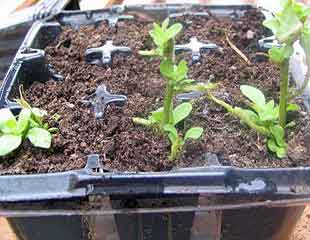
Easy to maintain Bedding plants
Some bedding plants are easier to maintain and keep looking good all summer than others.
In summary: Petunia, surfinia, verbena, pansies, Ice plants all hard work as they need lots of dead heading, plus French marigolds slug magnets, and sweet peas attention seekers. Geranium, Begonia, Calendula and Nasturtiums, easy and undemanding.
Petunia, surfinia, verbena, pansies, Ice plants ( Mesembryanthemum) all need a lot of dead heading, but some more than others. If you want an easy gardening life, Mesembryanthemum is not the bedding for you. This is because Mesembryanthemum, when in full bloom, produces dozens and dozens of spent flowers to be removed. As a bedding plant, it looks fab, but very labour intensive. See below the lovely bright blooms left, and the heap of spent flowers, all of which were removed in just one dead heading session, centre image.
If bedding plants are not dead headed, they will stop flowering earlier in the season. A plant flowers and sets seed, that it's aim, and having achieved this, it will not keep on flowering. By removing the spent flowers, it forces the plant to flower again in order to set seed and keep on flowering.
Sweet peas are another labour intensive bedding plant. Obviously beautiful scent and colours, but hard work. I grow them every year and I love them, but they take a lot of effort to keep them blooming and looking good. It is essential to keep removing the spent flowers and seed heads all summer long, and there will be plenty. Also, to stop the plant becoming a tangled knot by halfway through the summer, you need to remove the tendrils as well, see the image below right and tips on growing sweet peas.
Video about removing sweet pea tendrils.
Easier to grow and maintain are Pelargoniums, commonly also known as Geraniums, which are not troubled by slugs and need only a modest amount of dead-heading, and are drought resistant. Geraniums will benefit from a feed but will still put on a good show without being fed. Suttons have some great seasonal offers for summer Geraniums.
Geraniums can also be overwintered in a frost free environment to have free plants for next year.
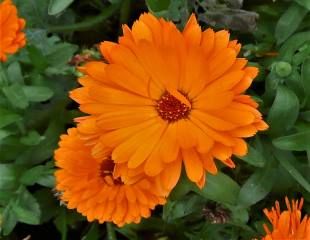
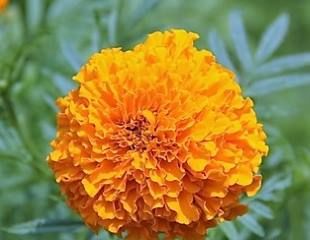
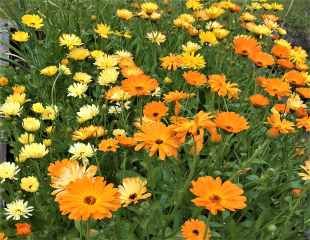
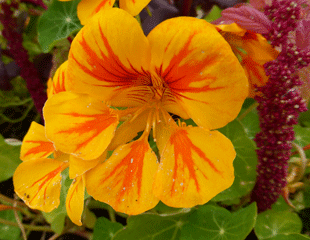
Equally easy to grow are Nasturtiums, which again are not attractive to slugs, fairly drought resistant and do not require dead heading. Nasturtiums are happy on poor soils so no need to feed. They are attractive to bees and pollinators making ideal companion plants for the veg plot.
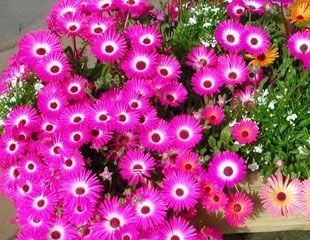
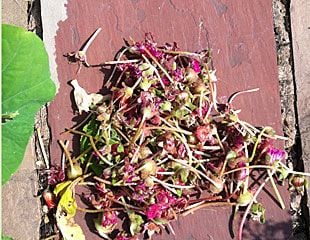
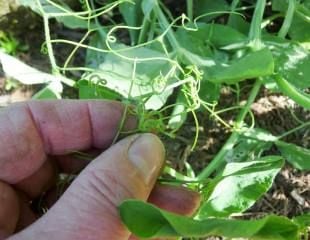
Bedding plants for shade and those which only open their flowers in sun.
No bedding plants will tolerate deep shade, but some will flower reasonably well in light or dappled shade. Impatiens will take shade, Begonia more shade, pansy and viola dappled shade. Antirrhinum, Nicotiana, and Fuchsia will also tolerate partial or dappled shade. Most other bedding plants require full sun to flower well.
Strangely enough, there are some bedding plants whose flowers only open with sun. That's important to know because it means if we have a poor summer, or a dull week, the flower will stay completely shut, which is not much of a display. You may to avoid these plants. In the image is the lovely Gazania, shown right, often an eager purchase at the garden centre which may fail to reward on a dull day; no sun, no flower. The same is true of Morning glory, beautiful annual climbing plant, Osteospermums and mesembryanthemum, the ice plant illustrated above.
